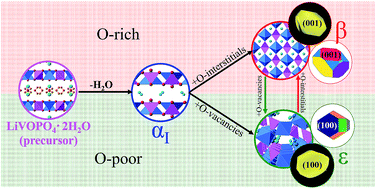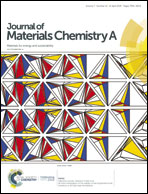Rational synthesis and electrochemical performance of LiVOPO4 polymorphs†
Abstract
LiVOPO4 is a promising cathode material for Li-ion batteries due to its ability to intercalate up to two electrons per vanadium redox center. However, LiVOPO4 exhibits polymorphism, forming either the αI, β, or ε phase. A thorough comparison between the properties of these phases is difficult because they usually differ in synthesis methods. In this study, we synthesize all three polymorphs by annealing a single precursor, LiVOPO4·2H2O, thereby reducing the effect of synthesis on the properties of the materials. We show through in situ XRD with heating and DFT calculations that, in terms of stability, αI-LiVOPO4 ⋘ ε-LiVOPO4 ≤ β-LiVOPO4. We also show experimentally and through DFT calculations that the tolerance to O-interstitials and O-vacancies can explain the differences in stability, morphology, and electrochemical performance between β- and ε-LiVOPO4. β-LiVOPO4 is more stable in the presence of O-interstitials while ε-LiVOPO4 is favored in the presence of O-vacancies. These defects affect the surface energies and morphology of the products formed, which are confirmed in the Wulff shape calculations and transmission electron microscopy images. These imply that β-LiVOPO4 has an improved rate performance under an oxidizing atmosphere due to the increased presence of facets with superior ion diffusion at the surface. This improved performance is seen by the improved rate capability and capacity of β-LiVOPO4 in the high-voltage region. In contrast, synthesis conditions have little effect on improving the rate performance of ε-LiVOPO4.

- This article is part of the themed collection: Celebrating the 2019 Nobel Prize in Chemistry


 Please wait while we load your content...
Please wait while we load your content...
